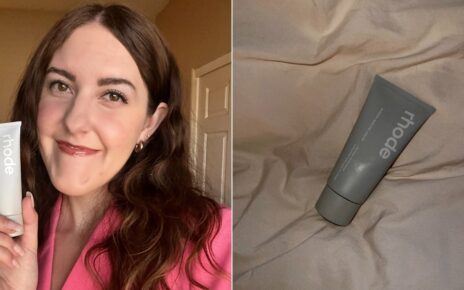Written by Zeynab Mohamed
Formaldehyde, the commonly used ingredient in permanent blow-dries and keratin hair treatments, can cause allergic reactions and hair loss.
Imagine my excitement, the answer to all of my hair woes – frizz-free, easy-to-manage hair, all thanks to a popular procedure known as keratin treatment. There would be good hair days in abundance, all thanks to my local hairdresser and a 90-minute appointment.
Described as a permanent blow-dry, a keratin treatment smooths out fluffy, frizzy strands from root to tip. It’s credited with transforming high-maintenance, hard-to-manage hair into the ultimate low-maintenance style.
What is a keratin hair treatment?
Also referred to as a Brazilian blow-dry, a keratin treatment involves straightening and smoothing the hair using a strong protein formula. This formula is then sealed into the hair using a hairdryer and straighteners. A lengthy process, one treatment can last anywhere between one to three hours depending on your hair length, texture and thickness.
Not to be confused with relaxing – in which the hair structure is permanently changed – the results of a keratin treatment can last between three and six months. As it is a temporary process, the hair will eventually return to its natural state afterwards.
You may also like
- Why you need to look after your scalp, plus the best treatments and products
- 13 best scrubs to shift dirt, pollution and product build-up on your scalp
What happened when I had a keratin treatment
Just under a year ago, in August 2021, I booked myself in for the hair-transforming treatment before my cousin’s wedding. I entered the salon with high hopes and, initially, I wasn’t disappointed.
However, soon after, my scalp felt itchy and sore and I was shedding balls of hair each day. Worried, I booked myself in to see my GP and he confirmed that I had indeed had an allergic reaction to the keratin and prescribed me a lotion to help calm and soothe my scalp.
While my hair looked great and was much easier to take care of, it didn’t feel worth it for the volume of shedding I was experiencing. With every touch, every brushstroke (and sometimes no contact at all), I saw hair fall to the floor. I was helpless, with no control over the hair loss. I tried remedy after remedy but nothing worked. By December, I had lost half my hair. It was disastrous.
Searching for answers, I took to the internet. I looked high and low but I wasn’t able to find a solution to my woes. There were hundreds of accounts praising keratin treatments for their newly smooth and manageable hair but nothing on what to do if your hair is falling out due to a bad reaction.
Why can keratin treatments cause hair loss?
Many keratin treatments contain the chemical formaldehyde. UK government guidelines define formaldehyde as a “colourless, corrosive, flammable gas with a pungent, suffocating odour”.
Used primarily as an adhesive and binder in many industries and processes, formaldehyde is commonly used to help produce other chemicals, as an insulating building material and as a cosmetic preservative.
Produced naturally (in very small amounts) in the body, formaldehyde is largely safe at very low exposure levels. In keratin treatments, formaldehyde is the chemical that works to set the hair into its new straight and smooth finish.
Founder of health assessment service Viavi, Dr Sabine Donnai, explains: “Formaldehyde is a chemical that is toxic to the system and can cause anything from skin irritation to asthma, loss of hair by affecting the hair follicles, as well as an increased risk of cancer through DNA adduct formation.”
She continues, “Studies have proved that most keratin treatment products have a concentration of formaldehyde that is five times higher than the recommended level” – and that’s even in some treatments that claim to be formaldehyde-free.
“DMDM hydantoin (a preservative and antimicrobial agent found in many beauty products that releases a small amount of formaldehyde over time to help keep preserve shelf life) is present not only in keratin hair products but in many shampoos as well. The DMDM hydantoin releases the formaldehyde and is linked with hair loss and hair brittleness through the toxic effect on the hair follicle,” adds Dr Donnai. It’s one of the most common allergens in cosmetic products, which explains why I reacted to it.
What to do if you have an allergic reaction after a keratin hair treatment
“The most important thing to do immediately after a reaction is to seek medical attention from your GP. They will be able to guide you through treatment options for moderate to severe reactions, these include treatments like antihistamines and sometimes even steroids,” explains Dr Simmy Kaur, resident GP at Monpure. “If the scalp feels hot to touch, if it becomes red or very itchy, it’s important to seek professional help.”
As well as seeking professional medical help, scalp care is vital following a keratin treatment, especially if you’ve had an adverse reaction.
An itchy scalp is no fun. Dr Kaur recommends Monpure’s nourishing scalp mask and hydrate and smooth serum to stimulate hair follicles to prevent hair loss and promote growth.
This will help to provide “immediate relief for an irritated scalp” and begin working at promoting hair growth.
While some hair shedding is perfectly normal and part of the natural hair journey, Dr Kaur explains more: “It’s normal to shed around 50-100 hairs per day. However, in reality, hair loss can vary tremendously from person to person and can vary between different textures. Thicker, coarser hair tends to shed less, while fine hair generally tends to shed more.”
What are the alternatives to a keratin treatment?
Consultant trichologist Susie Hammond MIT MRSPH recognises the benefits of keratin treatments, however, she also states: “We don’t really know the long-term effect of repeated treatment and whether, in fact, this is ultimately more damaging to the hair shaft, partly because of the amount of heat needed to make the fixative work.
“I try to make my clients aware that there may be some risk, and advise that with good use of hair masks such as Philip Kingsley Elasticizer Intensive Treatment, the right styling products and good blow-dry technique, you should be able to achieve lovely results without using harsh treatments.”
The most important takeaway from my experience – make sure to always do an allergy test beforehand and thoroughly research the hair salon before booking in. If there is no allergy test stated as necessary on the salon website, try phoning up at least a week before your appointment for a patch test. If any adverse reactions appear, you’ll know to cancel the appointment. If none do but you still feel unsure, speak to your hairstylist before the appointment, they’ll be able to answer your questions.
Main image: Getty
Source: Read Full Article

